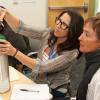
Residents Vivian Sha (left) and Beth Goldstein (center) consult with NP Tina Clark at Glide Health Services clinic in San Francisco (photos by Elisabeth Fall).
Are Residencies the Future of Nurse Practitioner Training?
When Beth Goldstein finished her nurse practitioner training at UCSF a couple of years ago, the thought of seeing patients completely on her own made her a little jittery. She was licensed to provide primary care and confident in her skills. Yet the idea of a little more practice had tremendous appeal.
Soon Goldstein was immersed in exactly the kind of hands-on learning she craved, as one of the first nurse practitioner (NP) residents in a new UCSF-UCLA nurse practitioner residency partnership, with Glide Health Services clinic in San Francisco and the Union Rescue Mission clinic in Los Angeles. Monday through Friday, at Glide’s bustling clinic in San Francisco’s Tenderloin District, Goldstein peers into wheezing lungs, palpates swollen glands, orders blood tests and listens carefully to descriptions of pain, dizziness and a host of other complaints – all under the guidance of an experienced nurse practitioner mentor.
The partnership, which is winding up its inaugural year, is part of a small but growing movement to create formal primary care nurse practitioner residency programs, similar to those for physicians – essentially a layer of on-the-job training after formal schooling. The effort, which began at a Connecticut community clinic five years ago and is spreading nationally, is geared largely toward honing nurse practitioners for community care or frontline jobs serving populations that tend to be low-income, uninsured, homeless, mentally ill and/or substance abusing.
Primary care provider shortages in these challenging settings are well documented, and projected to grow.
“Our experience is that NP graduates are searching for this support as they transition to practice, and we have had a huge response from students across the country to our new program,” says UCSF nursing professor Pat Dennehy, who directs the partnership and the Glide clinic. Dennehy is also the primary investigator of the three-year federal Health Resources and Services Administration (HRSA) grant funding the program.
“And administrators in community health centers, employers, are searching for providers with the training and proven competence to work with these complex populations,” she says.
For Goldstein, who volunteered at the Glide community clinic for years, prompting her to switch careers from architecture to nursing, the residency is truly a dream come true.
“Even before I knew that residencies existed, I’d wished for such a thing, thinking it would be amazing for nurse practitioners,” she says. “It was a dream that it existed, and a dream that it worked out for me.”
A Primary Care Partnership Takes Hold
Launched in January 2012, the UCSF-UCLA nurse practitioner residency partnership, now ramping up for its second year, offers four one-year residencies to certified nurse practitioners, two at each community clinic. The UCSF and UCLA schools of nursing oversee the program – and the partnership clinics – but it’s open to nurse practitioners nationwide.
To be sure, many nurse practitioner programs, including the one at UCSF, specialize in the kind of “whole person” primary care that’s well suited for community clinics, where health is deeply intertwined with challenges in housing, food, money, employment and transportation. The UCSF adult nurse practitioner program, which Goldstein completed, includes clinical rotations in community care settings, which provide meaningful windows into the work but are considerably shorter than residencies.
But the community setting is demanding, even for those who are excellently prepared. The extra in-the-trenches learning of a residency not only solidifies skills, but also acts as a testing ground for future work experience, says JoAnne Saxe, a professor in UCSF’s School of Nursing and faculty advisor for the residency partnership.
“We want to be able to groom the next generation of nurse practitioners to be not only well-prepared clinicians, but well prepared to work in these types of clinical environments. We’re dedicated to caring for these populations, and we want to be able to ensure we have clinicians who have this passion, as well as preparation,” Saxe says.
Teaching Skills and Boosting Confidence
In the partnership program, preceptors work alongside the residents, case by case, reducing their direct involvement as the year progresses and the residents' skills strengthen. Though residents enter the program certified to practice primary care independently, the mission of the residency is to reinforce their knowledge in the context of the complexity of needs common to community clinics, said Karla Ballesteros, a resident preceptor at Glide.
“The role of the mentor changes as the level of confidence and expertise of the residents evolves,” she says. “By the time the residents complete their hours to obtain a furnishing license [to prescribe medicines], the preceptor is still available, but now the role is more of a colleague. By the end of the residency, residents need consultation only on very complicated patients.”
At Glide, as at other residency clinics, the training includes mastering the wraparound, or team, approach to care, with as-needed consultation with physicians, social workers, psychiatrists, dentists and pharmacists.
“The critical-thinking skills you develop from this year of residency are priceless. It’s something you have to go through. You can’t teach it in lectures,” says Vivian Sha, the second inaugural resident at Glide. “It really teaches you how to think on your feet.”
Sha completed a nurse practitioner master’s degree program at Boston College in 2011, after working as a hospital RN for a year and a half. She commended her training, saying it included “extensive” clinical rotations. But still, Sha said, she didn’t feel comfortable jumping into a busy clinic holding the reins as a primary practitioner.
“I came out of my NP training feeling fairly unprepared,” Sha says. “One of the biggest things I’ve learned is to be more assertive; the program builds self-confidence. As a nurse, you’re taking a lot of orders and carrying them out efficiently. As an NP, you are the one giving orders. That role switch doesn’t always come easily.”
Thinking long-term for your patients, planning and monitoring follow-up care, is a highlight of the residency, Sha says. This can include teaching someone without a bathroom, kitchen or phone how to change a dressing, eat nutritiously on a tight budget or return for a critical appointment. “You have to be creative and thoughtful to provide comprehensive care,” Sha says.
The Origins of NP Residencies
The UCSF-UCLA partnership is modeled after the first nurse practitioner residency program in the country, started in 2007 at the Community Health Center, Inc., of Connecticut by Margaret Flinter.
Flinter, who launched the program in response to the escalating complexity of patient needs at community clinics, is consulting with the UC partnership as part of a collaboration of a dozen organizations that have or will soon have residency programs. Almost all are at federally qualified community clinics, which means they receive federal funding to provide comprehensive primary care to underserved populations, either on a sliding scale or for free.
It’s difficult to know how many other residency opportunities exist, as their number isn’t centrally tracked. The UCSF School of Nursing, for example, is overseeing another new nurse practitioner residency program at San Francisco VA Medical Center. In that program, however, the NP residents are known as fellows, and there is some debate about the proper term to use.
Community clinics serve 20 million patients today, and this is “projected to grow to 40 million over the next 20 years,” Flinter says. “And there’s no question that patients in these centers have very complex needs.”
Flinter – along with her UCSF colleagues Dennehy, Saxe and Karen Hill, who manages the Glide clinic – hope the nurse practitioner residency concept grows. There’s new urgency, they agree, as more people become insured under the Affordable Care Act (ACA), and nurse practitioners prepare to respond to the short supply of primary care providers.
Hope for Growth in the Future
But according to Flinter, this will happen only if secure funding is identified. Money is needed to pay for preceptors, resident stipends and administrative costs.
“There’s huge momentum in terms of the interest in the residency programs. There needs to be a sustainable path forward to meet the need,” she says.
Meanwhile, she calls the residencies a “slow-growing trend.”
If nurse practitioner residencies take hold, one inevitable question is whether they should be required, as they are for doctors.
Goldstein acknowledges that the requirement issue is tricky. “I absolutely recommend it to someone whose life can accommodate an additional year of training,” she says. But she also notes that residents currently earn stipends that are considerably less than even a starting salary, so it can be a tough call.
“I was eager to have the opportunity to practice under my own license, but with support and preceptorship – the way that medical residents do – before becoming completely independent,” she continues. “But I think many of my classmates felt ready to start working on their own as soon as they graduated.”
Dennehy believes NP residencies will evolve with the profession. “As NPs are called to provide primary care roles in the community, the residency experience will become the norm.”



